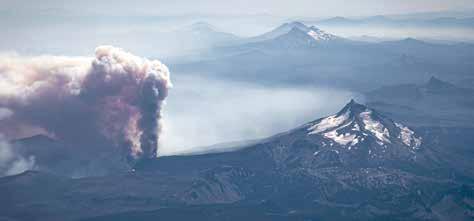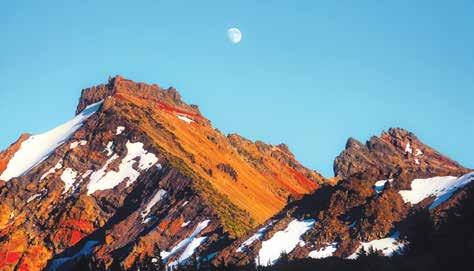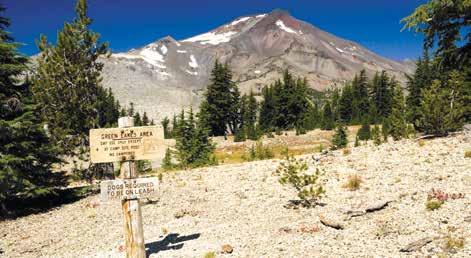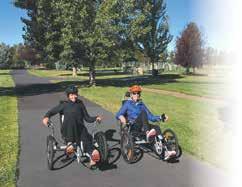
12 minute read
Feature
Post Fires, a Broken Pacific Crest Trail
Will the PCT’s Lionshead wildfire scars affect spring traffic?
Advertisement
By K.M. Collins
A tranquil day on the Pacific Crest Trail, through the lens of the author of the PCT thru-hiker’s “bible, Jordan Summers.”
It’s been a little over one week since the start of the official Pacific Crest Trail hiking season on March 1, and according to Scott Wilkinson of the PCT Alliance, only approximately 75% of the normal number of long-distance permits have gone out.
Fire on the Pacific Crest Trail in Oregon
Perhaps one of the causes of lower permit numbers: the wildfires that ripped through Oregon last year.
In August 2020, lightning sparked a fire in Lionshead Canyon on the Confederated Tribes of Warm Springs Reservation, about 14 miles west of the Warm Springs community. Soon after, while the blaze still raged, a historic windstorm rapidly spread fires west onto the Willamette, Deschutes and Mt. Hood national forests.
According to Inciweb, the inter-agency fire reporting system, the Lionshead Fire swept across 204,469 acres, heavily impacting the PCT.
Although much about the extent of damage is unknown (with many affected acres still tucked under a blanket of March snow) currently a 9-mile swath of the PCT is closed. The closure stretches from roughly mile 2,027, north of Pamelia Lake, to roughly mile 2,036, north of Jefferson Park—and the PCTA isn’t recommending reroutes.
“Generally, the PCTA does not describe or suggest detours for fire closures, often because the detours involve long road walks that can be impractical (and sometimes dangerous) to hikers. What we recommend is that hikers make arrangements for transportation around closures—and we leave it up to them,” Wilkinson said.
In addition, Wilkinson shared that the PCT had very little of its normal maintenance done in 2020 due to the pandemic. This could mean far more downed trees across the trail than in a normal year.
“Some sections could be in rough shape. We’re *recommending* that long-distance hikers postpone their hikes until 2022, but that is not a regulation or order; the PCTA does not have the authority to close the PCT.” Wilkinson encourages hikers to closely inspect the list of trail closures found on the PCTA site, because closures and transects needing triage go far beyond the aforementioned Lionshead section.
Another reason for a drop in thru hiker traffic is—you guessed it—the pandemic.
A few COVID measures the PCTA is recommending include doing single-day or single-overnights only, choosing to hike sections close to home. Other recommendations include avoiding resupply stops, only hiking with family or fewer than six people and following all Centers for Disease Control and Prevention guidelines.
During a regular season, only 15 to 20% of the people getting those permits end up hiking the whole trail to completion, Wilkinson said—sometimes due to cancellations, or because hikers are only hiking certain segments.
“Some people don’t intend to hike the entire trail, which is 2,650 miles,” observes Wilkinson. “But for those who do plan to, the attrition rate is extremely high. The vast majority don’t make it for a variety of reasons… most common are injuries, running out of money—and some just decide that walking
every day for six months with 30-40lbs on their back is not what they thought it would be!” To get a true picture of what this weird season on the PCT looked like, official data on permits and hikers will be available in the fall, Wilkinson said.
The PCT hikers’ bible
Hikers who do decide to embark on a longer PCT journey this year have the January 2021 refresh and release of what is essentially the PCT thru-hikers’ bible. Completely revamped, the author and veteran thru-hiker, Jordan Summers, said his book, “Pacific Crest Trail: Oregon & Washington,” has many improvements over the former edition. The most important of which, he shares, is, “The addition of full-page, full color maps with mileage annotations. These make navigation and planning much easier and more accurate for hikers of varied skills.”
Since the guide’s last iteration 16 years ago, many trail segments have been realigned, bridges installed (or demolished by flood), campsites removed, trail mileage and directional signs procured and more backcountry toilets installed. “These are all pretty vital for hikers to be familiar with,” notes Summers.
About wildfire prevention on the trail, Summers, also a certified Leave-No-Trace instructor, shares, “I am sure that a bit of education on stove and fire safety would go a long way to preventing accidental fires. Alcohol [as a stove fuel] is dangerous because the flame is invisible and cannot be regulated. It’s on or off. Forest duff—
needles, leaves, dried grass or moss—is not a safe place for a fire. I’ve seen many instances of both of these, and they are scary. In the San Bernardino Mountains, I did have to extinguish a large untended fire with handfuls of snow as glowing embers were sent over the area by high winds. Twenty minutes of scraping snow for someone else’s lack of knowledge.”
Although the Lionshead Fire was started by lightning, 2020’s humancaused fires based in Oregon included
Lucas Rietmann

A view from above of the Lionshead Fire, started by lightning on the Warm Springs reservation.
Jordan Summers
Brattain Lake, Leslie Gulch and Almeda Drive and the Beachie Creek fires. Officials suspect arson in the last two.
As Summers can attest, hiking amid wildfires can be scary—but he offers some advice based on experience.
“It’s unfortunate that fires don’t give any warning before they begin pumping smoke over your campsite. It’s a gross thing to wake up to, especially if you’re already rising in the dark and there’s no visual indication of where the fire is located,” he said. “No flames are visible. No onrush of fleeing wildlife to follow. Just gear up and keep hiking north. Cough. Cough. Check the fire reports if you have a signal; look for weather and fire alerts on your tracking device; watch for signs posted on trailside trees; follow the instructions on the signs. The smoke may be coming from a fire distant from your location, but you may still have to move forward—possibly walking into it. The amount of smoke will vary through the day, and so without other clues or instructions, hikers are somewhat on their own. If evac orders are posted, follow them to the letter.”
It used to be the only statistically significant barriers to hiking the PCT were mental. With the onset of global climate change, polar vortex shifts and emerging super viruses with innumerable variants, perhaps a future iteration of the thru-hikers’ Pacific Northwest bible will include some new post-apocalyptic sections.
Wilkinson’s and the PTCA’s final advice for this season: Prepare for differences from years past. “We’re telling everyone that 2021 will definitely not be a normal year on the Pacific Crest Trail. Between historic damage to the trail due to wildfires and the COVID-19 pandemic, it will be a very challenging year for anyone traveling long distances on the trail. Those who plan to hike the trail need to be adaptable, flexible, and understand that they may not make their goal this year.”
If anything, this season’s experience on the PCT will likely be a throwback to backpacking the trail a few decades ago, Wilkinson said. “This isn’t necessarily a bad thing for those who seek solitude and are prepared with a wilderness travel mindset.”
In 2020, Messes and Crowds Defined Many Forest Trails
National Forest use was up 40% last year in our region. This year, the planned permit system moves forward for some of the most popular trails—and hopefully, volunteer crews will return
By Damian Fagan
Many are happy to see 2020 in the rearview mirror. With a raging coronavirus pandemic, a contentious election, devastating wildfires, a crashing economy and stay-at-home orders, it was a no-brainer that when the light turned green, explosive recreational use would follow. Recreating and being out in nature was about the only game in town, so how did this “quintafecta” influence trails in Central Oregon?
“Initial figures show that we had about a 40% increase in visitor use this year,” said Jean Nelson-Dean, public affairs officer for the Deschutes National Forest. “In 2018, we did a formal survey of visitor use, which showed we have 3.3 million visitors a year to the Deschutes National Forest. If we look at a 40% increase of 3.3 million visitors, it was a phenomenal level of recreation use, which certainly overwhelmed our ability to serve all those visitors and did have impacts to the natural environment.”
A combination of increased visitor use, coupled with single-occupant cars, easily overwhelmed Central Oregon trailhead parking lots in 2020. Initially, campgrounds saw heavy use, but without trash service or restroom maintenance—and especially when they opened for reservations—were quickly filled by locals and visitors alike seeking solace and sanctuary.
“Last year, as we began dealing with the pandemic, we had no ‘play book’ and our primary focus was to protect our employees and our volunteers from exposure to COVID-19,” added Nelson-Dean. With staff working remotely and limited field crews, the Forest Service also postponed volunteer group activities for most of the season.
Though some volunteers were able to get out by mid-July, their numbers were limited by COVID-19 precautions. Coupled with some of the seasonal trail crew being switched over to fire duties because of budgetary restraints, the trails lacked early-season maintenance by the volunteer trail crews.
“A lot of the wilderness trails didn’t get logged out as early as they usually do,” said Richard Nix, board president for Friends of the Central Cascades Wilderness board. “Another thing that I noticed, especially on the narrow trails, was that when you met someone on the trail coming the other way, everybody was stepping off to the side of the trail, effectively widening the trails in some cases.” Nix’s group received permission from the Forest Service in September to resume cleaning up backcountry campsites and installing trails signs.
A side tangent to the crowded parking lots was that there weren’t parking spaces for the equestrian backcountry riders to park their trailers, forcing them to find another parking lot that could accommodate their rigs. Inadvertently, the crowded parking areas pushed users into other less-traveled areas of the forest, increasing the spread of impacts to different areas.
So how much did the lack of volunteers impact the local forests? “We have the second-largest volunteer program of any national forest in the United States,” said Nelson-Dean. “On average we have over 2,500 volunteers annually who contribute over $1 million worth of work to maintaining primarily recreation assets, but also do other work for us. If it wasn’t for the tremendous work of individual and group volunteers, we would not be able to maintain our 2,000+ miles of trails on the Deschutes NF.”
Deschutes Trails Coalition
Back in 2017, to address the rising recreational use on public lands, the Deschutes Trails Coalition, a group of over 30 partners that span the realm of tourism, businesses, corporations, environmental groups, user groups, community partners and land use agencies, formed.
“The Forest Service brought the DCT together in the first place at the behest of then Forest Manager John Allen,” said Danielle MacBain, DTC executive director. “He was the one who brought the initial groups together to get input on sticky issues around trails and recreation.” The USFS was getting input on issues from a variety of sources—sometimes in conflict between different user groups. With creation of the DTC, the groups could hash out issues together, then proceed forward with more of a cohesive approach.
“We work in a collaborative effort to work on sustainability issues for trails,” added MacBain. “Our sustainability goal is more holistic than just the physical aspect, but includes economics, social and environmental factors when we consider the work we do.” The DCT is not an advocacy group for adding trails, rather having “smart trails” that exist on the landscape which meet these sustainability criteria.
With numerous voices represented, the Coalition looks to add partners and hopes that will include an elected representative among the Deschutes County Board of Commissioners, something the group has been working on for a while, who will also represent the County at these meetings.
The DTC’s Small Project Grant Program is funded by its $1 for Trails program, as well as from the mobile donations received through Pledge for the Wild—a nonprofit co-organized by Visit Bend in partnership with other western mountain towns that promote responsible outdoor recreation.
David Mark / Pixabay Courtesy U.S. Forest Service


View of South Sister from the Green Lakes Trail in the Three Sisters Wilderness on the Deschutes National Forest in Oregon's Cascades.
Central Cascades Wilderness Permit System Goes Online
Last year, both the Deschutes and Willamette National Forests put on hold implementing the Central Cascades Wilderness Permit System, created to protect natural and cultural resources as well as the visitor experience by limiting entry at different trailheads in the Three Sisters, Mt. Jefferson and Mt. Washington wilderness areas. Using last season as a barometer, the Forest Service decided to go ahead with implementation of a limited-entry permit system this year from May 28 to Sept. 24. Users will be able to obtain a dayuse or overnight permit starting April 6, online through Recreation.gov. A portion of the permits will be issued in advance throughout the whole season, while others will be available seven days prior to the departure date.
Though not all the DTC partner groups agree on the permitting system, they did agree that there was a need to address increased recreational use.
“We’ve worked really hard internally to figure out how we are going to proceed with 30-plus partners,” said MacBain. She acknowledges that the groups don’t always agree, nor do they always agree with the actions the land management agencies take, but the two-way conservation is key to sustaining the ecological and social integrity of a regional trail system while maintaining protection for wildlife and a quality experience.
Many are excited to see 2021 out the front windshield. There’s hope on the horizon—and that means trail projects and volunteer activities are likely to resume at some point in time, an important point for not only the ecology of the forest but also the volunteers' spirits.
“We have learned many things over the past year, and it is our hope to have volunteers return to supporting us as soon as it is safely possible,” said Nelson-Dean. “We cannot maintain all our recreation assets on the Deschutes NF if it wasn’t for our volunteers. If you know someone who volunteers for the Deschutes NF, please say thank you!”








